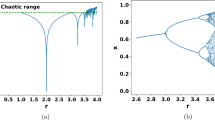Abstract
Recently, an image encryption algorithm based on scrambling and Veginère cipher has been proposed. However, it was soon cryptanalyzed by Zhang et al. using a method composed of both chosen-plaintext attack and differential attacks. This paper briefly reviews the two attack approaches proposed by Zhang et al. and outlines their mathematical interpretations. Based on these approaches, we present an improved chosen-plaintext attack to further reduce the number of chosen-plaintexts required, which is proved to be optimal. Moreover, it is found that an elaborately designed known-plaintext attack can efficiently compromise the image cipher under study. This finding is confirmed by both mathematical analysis and numerical simulations. The cryptanalyzing techniques developed in this paper provide some insights for designing secure and efficient multimedia ciphers.






Similar content being viewed by others
Notes
Instead of proving the effectiveness of Method II mathematically, the authors of [28] solved the problem by trying all possible combinations.
It should be noticed that pixels of the difference image between two cipher-images are not uniformly distributed in the encryption algorithm under study. It is equal to the difference of the two corresponding plain-images, as pointed out in Fact 2.
References
Alvarez G, Li S (2006) Some basic cryptographic requirements for chaos-based cryptosystems. Int J Bifurcation Chaos 16(08):2129–2151
Alvarez G, Montoya F, Romera M, Pastor G (2004) Cryptanalysis of dynamic look-up table based chaotic cryptosystems. Phys Lett A 326(3):211–218
Behnia S, Akhshani A, Mahmodi H, Akhavan A (2008) A novel algorithm for image encryption based on mixture of chaotic maps. Chaos, Solitons Fractals 35 (2):408–419
Biham E, Shamir A (1991) Differential cryptanalysis of DES-like cryptosystems. Adv Cryptol - Crypto 90 537:2–21
Chen Y, Liao X, Wong KW (2006) Chosen plaintext attack on a cryptosystem with discretized skew tent map. IEEE Trans Circ Syst II: Express Briefs 53(7):527–529
Chen G, Mao Y, Chui CK (2004) A symmetric image encryption scheme based on 3D chaotic cat maps. Chaos, Solitons Fractals 21(3):749–761
Fridrich J (1998) Symmetric ciphers based on two-dimensional chaotic maps. Int J Bifurcation Chaos 8(06):1259–1284
Jakimoski G, Kocarev L (2001) Chaos and cryptography: block encryption ciphers based on chaotic maps. IEEE Trans Circ Syst I: Fundam Theory Appl 48(2):163–169
Kim H, Kim M (2011) A selective protection scheme for scalable video coding. IEEE Trans Circ Syst Video Technol 21(11):1733–1746
Li C, Lo KT (2011) Optimal quantitative cryptanalysis of permutation-only multimedia ciphers against plaintext attacks. Signal Proc 91(4):949–954
Li C, Zhang LY, Ou R, Wong KW, Shu S (2012) Breaking a novel colour image encryption algorithm based on chaos. Nonlinear Dyn 70(4):2383–2388
Li S, Chen G, Mou X (2005) On the dynamical degradation of digital piecewise linear chaotic maps. Int J Bifurcation Chaos 15(10):3119–3151
Li S, Chen G, Cheung A, Bhargava B, Lo KT (2007) On the design of perceptual MPEG-video encryption algorithms. IEEE Trans Circ Syst Video Technol 17(2):214–223
Li S, Li C, Chen G, Bourbakis NG, Lo KT (2008) A general quantitative cryptanalysis of permutation-only multimedia ciphers against plaintext attacks. Signal Process Image Commun 23(3):212–223
Li S, Mou X, Cai Y, Ji Z, Zhang J (2003) On the security of a chaotic encryption scheme: problems with computerized chaos in finite computing precision. Comput Phys Commun 153(1):52–58
Li S, Zhao Y, Qu B, Wang J (2012) Image scrambling based on chaotic sequences and Veginère cipher. Multimedia Tools Appl 66(3):1–16
Li W, Yuan Y (2009) Improving security of an image encryption algorithm based on chaotic circular shift. In: Proceedings of IEEE international conference on systems, man and cybernetics (SMC), pp. 3694–3698
Mao Y, Chen G, Lian S (2004) A novel fast image encryption scheme based on 3D chaotic baker maps. Int J Bifurcation Chaos 14(10):3613–3624
Riad AM, Hussein AH, El-Azm A (2012) A new selective image encryption approach using hybrid chaos and block cipher. In: Proceedings of 8th international conference on informatics and systems (INFOS), pp. 36–39
Shannon CE (1949) Communication theory of secrecy systems. Bell Syst Tech J 28(4):656–715
Solak E, Çokal C, Yildiz OT, Biyikoġlu T (2010) Cryptanalysis of Fridrich’s chaotic image encryption. Int J Bifurcation Chaos 20(5):1405–1413
Trappe W, Washington LC (2002) Introduction to cryptography with coding theory. Prentice Hall, Upper Saddle River
Yang YG, Pan QX, Sun SJ, Xu P (2015) Novel image encryption based on quantum walks. Sci Rep 5(7784):1–9
Zhang LY, Hu X, Liu Y, Wong KW, Gan J (2014) A chaotic image encryption scheme owning temp-value feedback. Commun Nonlinear Sci Numer Simul 19(10):3653–3659
Zhang LY, Li C, Wong KW, Shu S, Chen G (2012) Cryptanalyzing a chaos-based image encryption algorithm using alternate structure. J Syst Softw 85 (9):2077–2085
Zhang Q, Guo L, Wei X (2010) Image encryption using DNA addition combining with chaotic maps. Math Comput Model 52(11):2028–2035
Zhang Y, Xiao D,Wen W, LiM(2013) Cryptanalyzing a novel image cipher based on mixed transformed logistic maps. Multimedia Tools Appl 73(3):1885–1896
Zhang Y, Xiao D,Wen W, Nan H (2014) Cryptanalysis of image scrambling based on chaotic sequences and Vigenère cipher. Nonlinear Dyn 78(1):235–240
Author information
Authors and Affiliations
Corresponding author
Rights and permissions
About this article
Cite this article
Zeng, L., Liu, R., Zhang, L.Y. et al. Cryptanalyzing an image encryption algorithm based on scrambling and Veginère cipher. Multimed Tools Appl 75, 5439–5453 (2016). https://doi.org/10.1007/s11042-015-2511-y
Received:
Revised:
Accepted:
Published:
Issue Date:
DOI: https://doi.org/10.1007/s11042-015-2511-y





